David Clapp
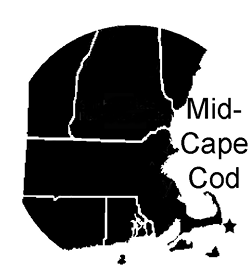 When I started contemplating this article on winter birding on mid-Cape Cod, I began by thinking about and reliving the great advice and information provided over the years by the Bird Observer "Where to Go Birding" articles that gave step-by-step directions necessary to find the location and, with luck, the birds.
When I started contemplating this article on winter birding on mid-Cape Cod, I began by thinking about and reliving the great advice and information provided over the years by the Bird Observer "Where to Go Birding" articles that gave step-by-step directions necessary to find the location and, with luck, the birds.
Today, eBird hotspots and various forms of instant communication have created a cultural shift in planning birding trips. Every phone and many cars have GPS and directional apps installed. In this article, I do not include turn-by-turn directions in most cases; that is for your phone to do. The emphasis is to provide you with a big-picture sense of the mid-Cape to help you plan the day or think about getting to a specific beach or bird. Birding the mid-Cape is easily done in a single day for many people. This route provides a round trip with stops at salt and fresh water, sandy beaches, and woodlands.
The saltwater shores of Cape Cod— we have a northern, southern, and eastern shore to bird on this trip—are rarely frozen and can harbor lingering seabirds and shorebirds. There are many bay and sea ducks, including Buffleheads, Red-breasted Mergansers, Common and Red-throated loons, Red-necked and Horned grebes, as well as Iceland and the occasional Glaucous gulls that frequent the shoreline throughout the winter. And those few ponds that do freeze late, or not at all some years, are often havens for freshwater ducks such as Common and Barrow's goldeneyes, Buffleheads, Redheads, Canvasback, Ruddy, Mallard, and Black ducks, and lots of Hooded Mergansers.
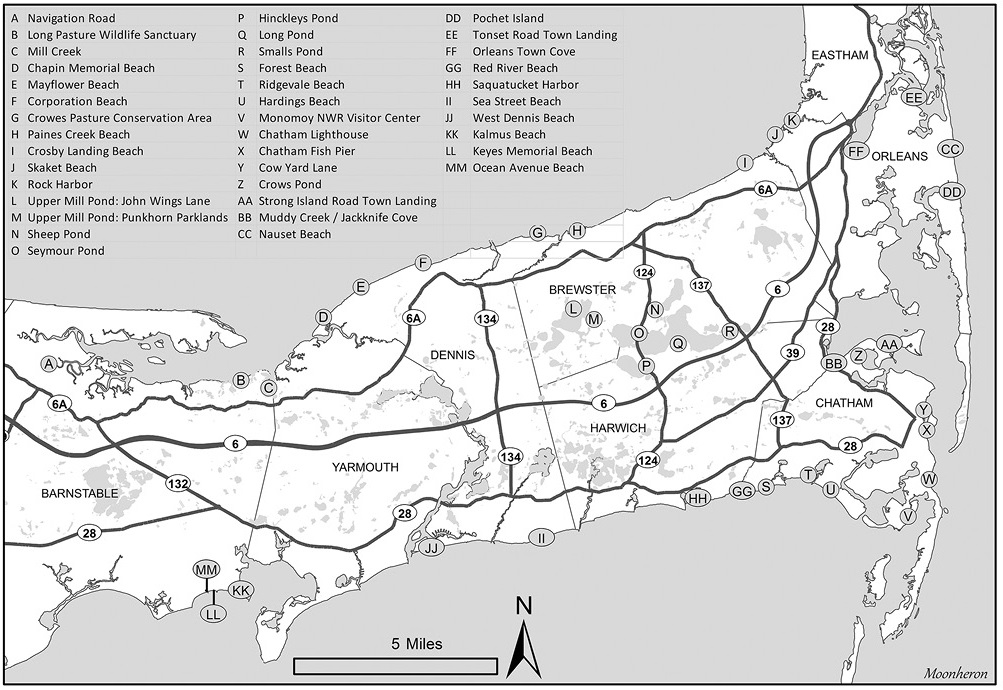
Fig. 1. Mid-Cape Cod Overview
Be Prepared
Remember, Cape Cod is unforgivingly cold and windy in the winter. The mid-Cape isn't as rugged as the Atlantic shore, but you should always add a waterproof windbreaker, an extra sweater, and a hat that covers your ears to your gear. Pack some food, check the tides, and ballpark your route. The good news is that traffic will not be a problem in the winter, even on Route 28 and the Sagamore and Bourne bridges. Although it is a bit of a challenge to find birding hotspots when wearing gloves and a parka, all is not lost. As a matter of fact, there is an unencumbered feel to winter birding that you don't get in any other season.
Cape Cod can be really quiet in the winter. Falmouth and Hyannis still pulse with life, but the roads are often empty and the outer Cape is all but abandoned of people. Lunch stops are few and far between. The mid-Cape has more Dunkin's than the outer Cape, so check your phone for the nearest coffee and restroom stops. On Route 6, there is a major rest area off Exit 6–Route 132 with a Dunkin, Subway, Burger King, and an open gas station.
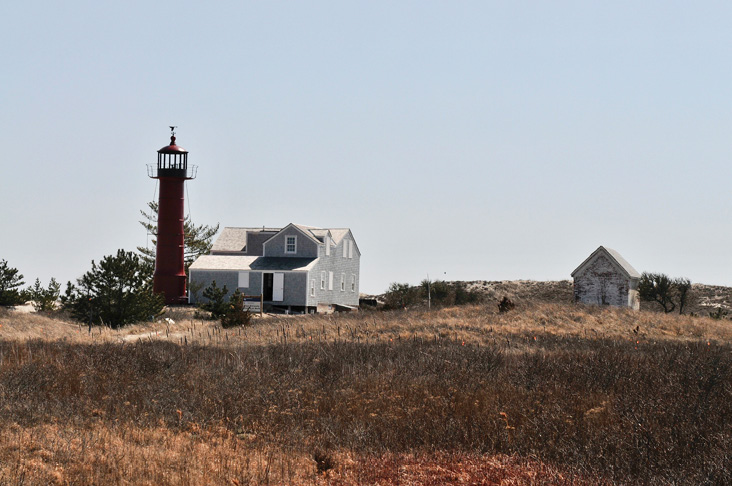
The lighthouse on South Monomoy. All photographs by the author.
How to Use this Article
A winter outing to Cape Cod can be a day trip or a weekend excursion, depending on how much of the Cape you want to cover. You can combine birding the mid-Cape with Falmouth and the upper Cape, or with the outer Cape from Orleans to Provincetown. Winter birding depends on how much daylight there is between December and March, how much time you have, and how much of the Cape you want to explore thoroughly. The sectional approach of this article gives you the flexibility to decide where you want to end up if you are going to stay for more than one night.
The mid-Cape Cod overview map (Figure 1) covers the area east of Route 149—Exit 5 off Route 6— to the Orleans Rotary and includes most of Barnstable, Dennis, Yarmouth, Harwich, Brewster, Chatham, and Orleans. There are three relatively parallel roads that take you east to west or west to east: Route 6A is on the north or Cape Cod Bay side; Route 6, the main highway and usually the fastest road, runs centrally to the Eastham/Orleans rotary; and Route 28 runs on the southern side nearest to Nantucket Sound, then turns north in Chatham. Because the connecting north-south links are rarely actual north-south roads, it is best to make a plan before starting out; think of mid-Cape birding in terms of the nearest exit off Route 6.
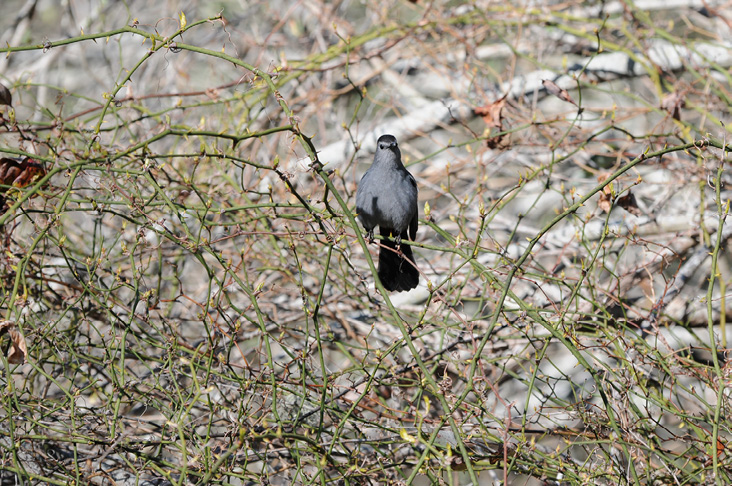
Gray Catbird in thicket.
The paramount birding places on the mid-Cape are Monomoy National Wildlife Refuge on Chatham's Morris Island and Nauset Beach in Orleans, with several stops around them. How and when you get there is up to you, but don't miss the "elbow" of Cape Cod and environs. If you follow these mid-Cape stops in alphabetical and numerical order—the excursion begins on the northern bay side and ends on the southern Nantucket Sound side with a Chatham/Orleans loop in the middle—the round trip route looks a like a three-quarter figure-eight on its side. Morning light will be in your favor if you start along Route 6A and end up on Nantucket Sound; however, if you love winter sunsets over the water, you might want to start in Hyannis and end the day birding the bay beaches from Brewster to Barnstable.
One of the easiest aspects of birding Cape Cod in winter is that you usually do not need to be as attuned to the tides as during spring and fall migration. The winter ducks and gulls will be around at high or low tides. The exception is birding the Monomoy National Wildlife Refuge (NWR) on Morris Island in Chatham, when it is better to be there on a low tide or within an hour or two of low tide. Also, Cow Yard Lane and the Chatham Fish Pier, while not prime winter hotspots, are better at low tide. So plan accordingly. Gray seals are best seen from the Chatham Fish Pier, which is located between Main Street and the Chatham Bars Inn on Shore Road. It is best to park in the upper lot and scope Tern Island (just offshore) from the observation platform—you won't need a scope for the seals. Tern Island is a good loafing area for gulls of all sorts. Glaucous and Lesser Black-backed gulls have been annual at the Fish Pier.
Winter passerine birding is also fairly straightforward on the mid-Cape. Much of the inland Cape is residential with public birding hotspots featured around boat ramps and conservation land. Many towns have websites for their conservation land trails, and this is your best bet if you want to plan specific places to explore woods and thickets. However, on most of Cape Cod, there are countless small thickets that can harbor Hermit Thrushes, Yellow-breasted Chats, Gray Catbirds, Eastern Towhees, Fox Sparrows, and lots of "feeder birds." Pishing at almost any thickety pitch pine spot will yield Tufted Titmice, Black-capped Chickadees, Red- and White-breasted nuthatches, House Finches and Goldfinches, and any of four common woodpeckers: Northern Flicker, Downy, Hairy, and Red-bellied Woodpeckers.
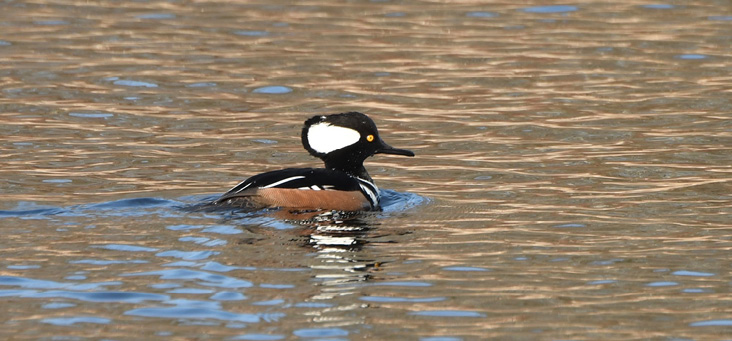
Hooded Merganser.
1. Barnstable to Dennis (Cape Cod Bay Side)
Start your mid-Cape birding trip in Barnstable on Navigation Road (A). Take Exit 5–Route 149 North to Route 6A, turn left onto Route 6A (Main Street), then turn right in 0.3 mile onto Navigation Road, a short unpaved street that heads north into the Great Marshes. This is an avenue of potholes and thickets that can produce passerines that are hanging on to their summer homes or sheltering after being caught a bit farther north than they wanted to be. It is a good spot to spend an hour or so. Continuing east on Route 6A, stop at the Long Pasture Wildlife Sanctuary (B), a Mass Audubon property at the end of Bone Hill Road, Barnstable. You can explore 2.5 miles of trails through thickets, tidal flats along the shore, and restored vernal pools, as well as bird the feeders. Like many places on Cape Cod, there are wet swales and drainages here that enhance the thickets; check these whenever you come across them. A sanctuary map is available for download.
Return to Route 6A and head east. A left turn onto Keveney Lane will take you out to the Mill Creek area (C) where Barnstable and Yarmouth share a boundary. When you cross the bridge into Yarmouth, the road becomes Mill Lane and will loop you back to Route 6A. This short diversion can provide tidal pond birds and freshwater and saltwater ducks. Northern Pintails and Green-winged Teal are regular in the fresh water; Red-breasted and Hooded mergansers are easily seen near the bridge over the tidal stream. Add Brant and gulls—as well as a look at a very pretty part of the bayside shoreline. Continue east on Route 6A through Yarmouthport to Dennis, where a couple of bayside beaches may be productive for birds on the sand—such as lingering Black-bellied Plovers and Sanderlings, but more likely small flocks of Dunlin—and in the water. This shoreline is best for gulls and water birds that like salt marsh edges, such as Red-breasted Mergansers and Black Ducks. The beaches are located for the most part in residential areas, and you may want to refer to a map or GPS to reach them. For Chapin Beach (D), take a sharp left onto New Boston Road, then take Beach Street and Taunton Avenue to Chapin Beach Road. For Mayflower Beach (E), stay straight on Beach Street to Horsefoot Path, then turn right on Dunes Road.
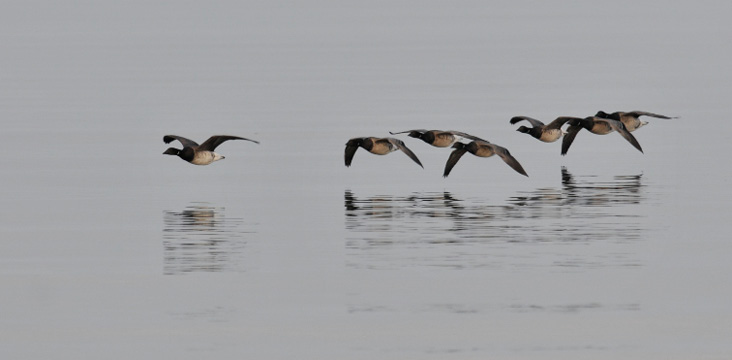
Brant flock.
The best beach on the northern side for windblown winter birds is Corporation Beach (F) at the end of Corporation Road in Dennis. The parking lot is protected by a rock berm, and as you sit there during a storm you will be thankful that the water has been slowed down. Northeast winds funnel their energy here, bringing all sorts of gulls, ducks, jaegers, loons, and occasional alcids and phalaropes. Corporation Beach is a fairly reliable spot on Cape Cod Bay for Dunlin, Harlequin Ducks, and the occasional King Eider. This spot has hosted Ross's Gull—a spring sighting—and Brown Booby in summer. Depending on the wind, temperature, and depth of the season, this shoreline is a great spot for observing Northern Gannets as they work to the south or return to their northern breeding grounds. During and after a winter northeasterly storm, this parking lot may sometimes be closed due to accumulated debris and wave wash.
For a walk in a conservation property that includes a variety of habitats—open space, thickets, beach, and pond—head out to Crowes Pasture Conservation Area (G) in Dennis. Quivett Creek forms the boundary between Dennis and Brewster. In the early part of the winter, a stop here can be productive for lingering land birds such as Yellow-breasted Chats, Gray Catbirds, Baltimore Orioles, and Eastern Phoebes as well as a modest number of Brant, Buffleheads, Black Ducks, Red-breasted Mergansers, and Common Loons. To get here from Corporation Beach, return to Route 6A and travel east, then take a left onto South Street. South Street curves to the right; keep following it into the property. A trail map is available for download.
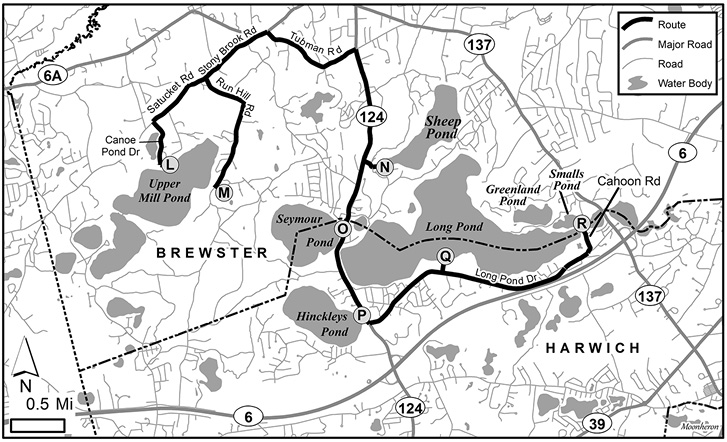
Fig 2. Map of Brewster and Harwich Lakes
2. Brewster to Orleans (Cape Cod Bay Side)
Brewster has seven beaches with small parking lots. None of them are terribly exciting birding destinations, but if you are driving along Route 6A, they make for a nice series of stops. You will add Brant and Dunlin to your day list somewhere along the Brewster shoreline if you haven't already picked them up at Corporation Beach. The two most productive of the Brewster beaches are Paines Creek Landing (H) and Crosby Landing (I). After a northeast storm, the flats near Paines Creek Landing can be good for gulls, phalaropes, and other windblown birds.
The same can be said for Skaket (J) and Rock Harbor (K) beaches in Orleans. They are pretty stops with occasional birds but are rarely exceptional. However, at any of these beaches in Brewster or Orleans, a walk along the bayside edge of the vegetated dunes may yield a Short-eared Owl, Horned Larks, and winter finches, especially Common Redpolls. You can choose to visit several bayside beaches or focus on one or two.
3. The Brewster and Harwich Lakes
Inland, there are several large ponds in Harwich and Brewster between Route 6A and Route 6 that have a modest reputation for birds and can be productive despite limited access. (See Figure 2.) Conveniently, the best way to get from Brewster to Chatham's beaches on Nantucket Sound is through this part of the mid-Cape via Route 124 (Exit 10 N on Route 6) and Route 137 (Exit 11). Rather than give a turn-by-turn route for the lakes section, I am listing the stops from west to east and north to south. You can determine your route based on the direction you are coming from.
Stops (L) and (M) are at Upper Mill Pond in Brewster. A bit off the beaten path, this large pond offers reasonable birds, but they tend to be spread out, and there are only two viewing spots, so I would consider it a last choice. Stop (L) is from John Wings Lane (from Route 6A, go south on Stony Brook Road, take a left fork onto Satucket Road, then turn right on Canoe Pond Drive to John Wings Lane to Upper Mill Pond Landing). Or you can see the pond from the Punkhorn Parklands parking lot (M), which is along Run Hill Road past the Town Transfer Station (from 6A, go south on Stony Brook Road and turn right on Run Hill Road). You could get Buffleheads, all three mergansers, lots of Common Goldeneyes, and in most winters, a Bald Eagle or two.
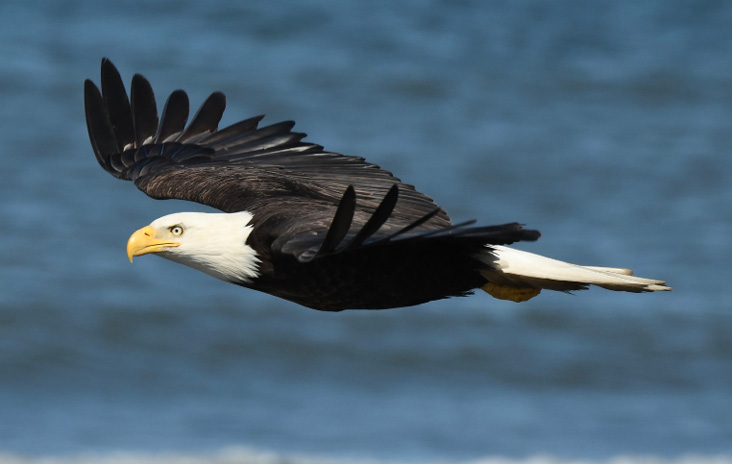
Bald Eagle.
The next three stops are off of Route 124, heading south from Route 6A. The first stop is Sheep Pond (N) in Brewster. Turn left on Fisherman's Landing Road and drive to the boat ramp, which is a good spot to look for Bald Eagles, Black Ducks, and Mallards. As Bald Eagles have become more common on Cape Cod, it is regular now to see eagles in the air over any of these ponds. There were at least two nesting attempts by Bald Eagles on the Cape, one near these ponds, in 2019.
Continue south on Route 124, which passes between Seymour, Long, and Hinckley (sometimes called Pleasant Lake) ponds, with good views of open water and the bike path. The access to Seymour Pond (O) is not easy to see; it's on the right just over the Harwich line as the pond comes into view—yes, drive (carefully) over the bike path to reach the small, sandy parking area.
Still north of Route 6, look for the red store (Local Flavor at the Pleasant Lake General Store) on the right. Park here and look at Hinckley's Pond (P) from the bike path. Hinckley's Pond has more birds per acre than the other two ponds. This is a good spot for American Coot, Ruddy Ducks, Greater and Lesser scaup, Ring-necked Ducks, Common and Barrow's goldeneyes, Buffleheads, Red-breasted and Common mergansers, Common and Red-throated loons, and Bald Eagles.
Long Pond is a scaup loafing pond that sometimes includes the scaup-cousin, Tufted Duck; the pond is best observed from the southern end along Route 124. This is usually the best pond for Barrow's Goldeneyes. There is a public boat ramp on Long Pond Road (turn right off Route 124 just south of the red store) that allows a pretty good look at the middle of Long Pond (Q).
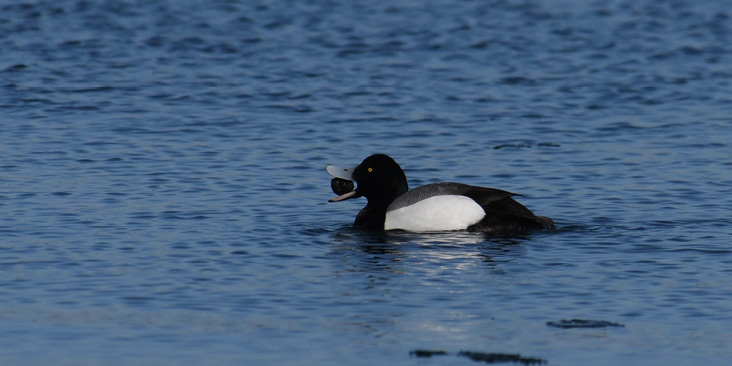
Greater Scaup with Fresh Water Mussel.
There is one more pond with Ring-necked Ducks, Hooded Mergansers, and an occasional Pied-billed Grebe, that is easily reached and worth a quick look. This small but productive site is actually named Smalls Pond (R). It is adjacent to Cahoon Beach Landing, the northern parking lot at Long Pond. (Some people might remember looking for the Tufted Duck that was here for a month or so a couple of years ago.) Get out of your car and take a few steps to the right, away from Long Pond, and look in the back of Smalls Pond. When you are done birding, return to Long Pond Road and head east to Route 137. You can use a map to locate the Hamilton Cartway (off Route 137, usually rutted and bouncy) that takes you to Greenland Pond. This interior pond is usually replete with all three mergansers and other ducks. When you finish birding the lakes section, take Route 137 to get to Route 28 to explore Chatham's beaches.
4. Chatham
The mid-Cape southern Route 28 side may be a bit better than the Route 6A side, but it, too, is usually quiet. The wintering sea and bay ducks seem to favor the wild eastern waters of outer Cape Cod as opposed to the calmer and more sheltered waters of Cape Cod Bay and Nantucket Sound. But driving along this southerly shoreline on Route 28 offers several birding stops with potential that will be discussed later in. The focus now is Chatham (see Figure 3)—the premier destination for a mid-Cape winter birding trip. (You can decide whether to get there from Route 6A, Route 28, or if you simply want to start your day of mid-Cape birding in Chatham by taking Route 6, to Exit 11—Route 137 Brewster/Chatham.)
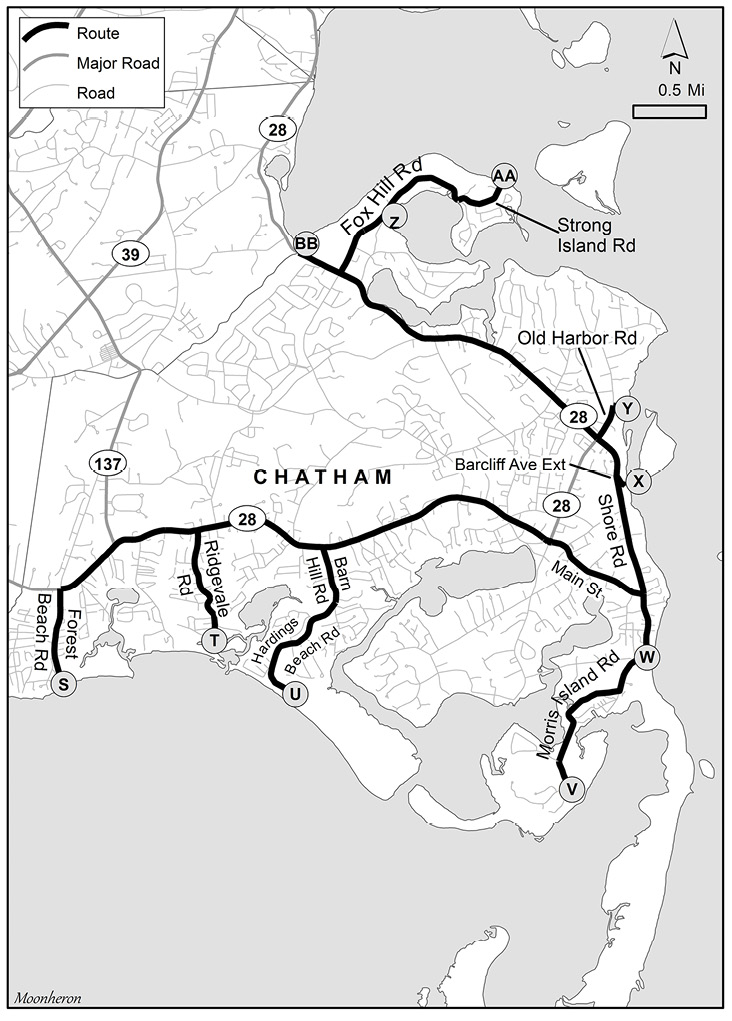
Fig. 3. Map of Chatham
Once you enter Chatham things begin to change; there are more beaches exposed to the open ocean and many more wintering seabirds when you start heading north. Forest Beach (S) and Ridgevale Beach (T)—basically a continuation of the other Nantucket Sound beaches—are worth a stop along the southern shore if you have the time. Hardings Beach (U) merits a longer walk along beach to look for Common Eiders, White-winged Scoters, Red-breasted Mergansers, and Common Loons as well as white-winged gulls and the occasional lingering Laughing Gull on the water. On the way back to your car, take the sand road between the dunes—it's a bit more protected from the elements—and look for Horned Larks. To get to Hardings Beach from Route 28, turn south on Barn Hill Road, and take the right fork onto Hardings Beach Road.
As you travel around the "elbow" of Cape Cod, conditions are dynamic. It is at the far edge of this mid-Cape block of land where you will see the most birds and experience the most significant chill factors. In winter, the northeast wind usually blows along the Chatham coastline, often carrying cold, damp ocean air; but sometimes it shifts to a northern blast from Canada. In either case, there are several birding stops that will make the discomfort worthwhile, but do plan for the most extreme weather and hope that it doesn't occur.
The barrier beaches are breaking and reforming and access is not predictable from year to year. Shoaling has pretty much eliminated the ferries that we took for decades to North and South Monomoy Islands during the summer and fall. About five years ago, the Town of Chatham stopped putting out channel markers that guided you below North Monomoy along the inside of (then) South Beach to South Monomoy because the shoaling was so unpredictable and the tidal range so great that there was no sure way to keep the inside water routes down to South Monomoy open and safe. There are now channel markers that get you toward the breaks in the beach leading into the Atlantic and also around to the west into Stage Harbor and Nantucket Sound. It is probably best to leave your boat at home and charter a boat locally if you want to get to the Mini and Monomoys. It is a very risky thing to do in the winter, and chartering in the winter is probably impossible anyway. The best and most easily accessed birding now is at the Monomoy National Wildlife Refuge (NWR) headquarters on Morris Island (V), which is the southernmost point from which you can start to look eastward. The refuge includes the various Monomoy islands and all the flats associated with them. In the winter, getting out to the islands would be treacherous. Nowadays with seals, sharks, shoaling, and tides, access is quite restricted even in summer.
The easiest way to get from Hardings Beach to Monomoy NWR headquarters in winter is to go through the center of Chatham (you might take an alternate route during the summer). Take Route 28 into Chatham. At the rotary, Route 28 veers left; be sure you continue straight on what is now Main Street, through town, then turn right at the stop sign to remain on Main Street to Chatham Light. Just past the lighthouse, continue straight down the hill, which is now Morris Island Road. At the fork, take a right to remain on Morris Island Road and follow it across the causeway, where it becomes Tisquantum Road. Follow the signs to Monomoy NWR, turning left onto the very short Wikis Way, then park at the headquarters (V). There are several signs that might lead you to believe that you are on private roads and not welcome, and that is true once you pass the refuge entrance, so be sure to park only at the refuge headquarters. The bathrooms may be open and there are bird feeders nearby that attract winter visitors and lingering migrants. It is worth stopping here just for the feeders. Redpolls and White-crowned Sparrows are regular as are orioles and Red-winged Blackbirds.
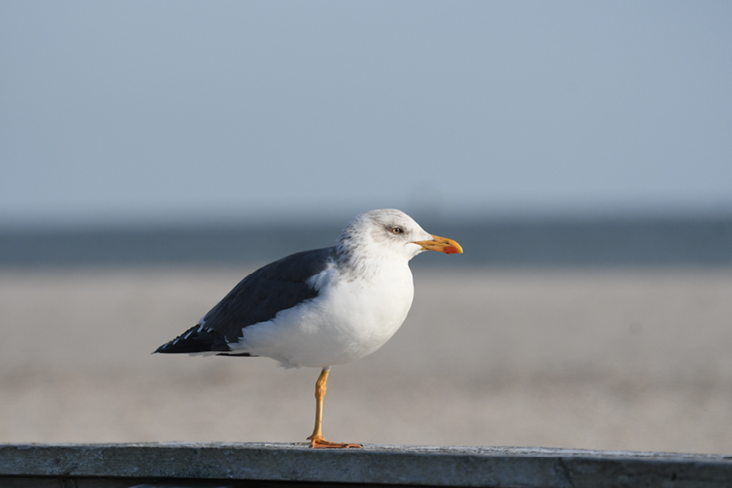
Lesser Black-Backed Gull.
After examining the feeders, follow the boardwalk trail to the overlooks and the stairs to the beach. Scan from here for Brant, Common Eider, all three scoters, Red-breasted Mergansers, Bufflehead, and Common Goldeneyes. There will also be Common and Red-throated loons and the occasional Horned Grebe in the waters just below, which is the shallow expanse between South Beach and Morris Island. From the overlooks, scope the sandy beaches of South Beach to the east for Snowy Owls. To the right of the stairs, you can see North Monomoy and South Monomoy islands across the water; they extend for several miles farther southward. Scope the islands for gulls. You can walk toward North Monomoy on the beach on a low tide. Be sure to get off the beach before half tide, because the water will rise right up to the bank—you will get wet if you misjudge the tides. You don't want to spend too much time on the Morris Island beach in winter.
There can be Great Cormorants anywhere along the Nantucket Sound beaches leading to Chatham and along the eastern beaches as well. In the Monomoy area, they are likely to be on any rocky projection, exposed piling, or simply standing on a sand bar offshore at low or half tide. It is also likely that Double-crested Cormorants will linger on Cape Cod. Size is one of the best field marks, and as winter wanes, Greats begin to develop white feathering around the throat and white thigh patches.
Bird Observer published a detailed article on "Birding Morris Island and Vicinity, Chatham, Massachusetts," by Ryan Schain that focuses primarily on fall migration from August to November but mentions the other seasons as well. It appears in Bird Observer Volume 43, Number 4, August 2015, and online at www.birdobserver.org. The article covers the inland trails on Morris Island, which are worth exploring, as well as the beach.
When you are finished birding Monomoy NWR, drive back to the Chatham Lighthouse (W) and stop and scope from the roadside parking area across the street. There is a lot of sand here and nothing will be close, but all sorts of things are possible. In the winter, there will certainly be gray seals and Common Eiders, and usually lots of other ducks, mostly American Black Ducks.
The next stop is 1.3 miles farther north: the Chatham Fish Pier (X). Stay straight on Main Street, which becomes Shore Road. Park in the upper lot only, please. There are bathrooms (where classical music is piped in). Down the stairs and past the fish storage area there is an observation deck, newly renovated in 2019, that allows for a reasonably close look at Tern Island; North Beach Island, farther out, still has two houses on it (as of this writing, August 2019). There will be gulls here, often including white-winged gulls— Iceland and Glaucous—and occasionally a Lesser Black-backed Gull. The fishing boats will be unloading skate wings (a bit like scallops, don't overcook) and spiny dogfish (a small shark, exported for fish and chips), and this economy will bring seals right in under your nose. Reasonable photos with a cell phone are possible of gulls and seals both.
Before leaving the observation deck, check out the shoreline of Tern Island, which is a good spot for shorebirds to linger. Most of them will be on the northern side of the island at half tide, but look anyway. This is a pretty good spot for early and late American Oystercatchers.
Head north again on Shore Road, proceed about a mile, and turn right at the traffic light onto Old Harbor Road, then turn right onto the town landing at Cow Yard Lane (Y), a sand road only a hundred yards long. Drive or park and walk to the end and look across the water at the northern end of Tern Island. At half and low tides this area opens into a sand flat and is a choice feeding area for shorebirds. It is, of course, best in the spring and fall but is always worth a look, often with a scope. In winter, you will see Brant, Canada Geese, Black Ducks, Mallards, Common Eiders, White-winged and Surf scoters, Red-breasted Mergansers, Buffleheads, Common Loons, the usual winter gulls with a few Bonaparte's now and then, as well as Dunlin on the flats. The thickets on the side of the short road will yield winter passerines, and sometimes a Red-tailed or Cooper's hawk perches on top of one of the eastern cedar trees.
Drive back to the traffic light and turn right; you are now on Route 28 driving north (although the signs say Route 28 south). In 2.2 miles, turn right onto Fox Hill Road. In 0.6 mile, you will see Eastward Ho Country Club on the left. On the right is Crows Pond (Z), a mostly-enclosed tidal pond that can be good for Barrow's and Common goldeneyes and Black Ducks, as well as Buffleheads and Red-breasted and Hooded mergansers. Drive into the small parking lot and get out and scope the pond. When you are done, turn right on Fox Hill Road, which takes you through the Eastward Ho Country Club's golf course where large flocks of Canada Geese graze. Sometimes these flocks yield a Snow Goose or White-fronted Goose. Past the golf course, turn left onto Strong Island Road to the town landing across from Strong Island (AA). The strait between Pleasant Bay (to the left) and Chatham Harbor (to the right) is often teeming with hundreds, if not thousands, of Common Eider. You can also find Buffleheads, Red-breasted Mergansers, and Black, White-winged, and Surf scoters, although not in the impressive numbers of the eiders. King Eider have been mixed in this gathering on several occasions; if you have the time and warm enough clothing, slowly scan for this attractive winter visitor. Turn around and head back down Fox Hill Road to Route 28, checking the geese on the golf course one more time.
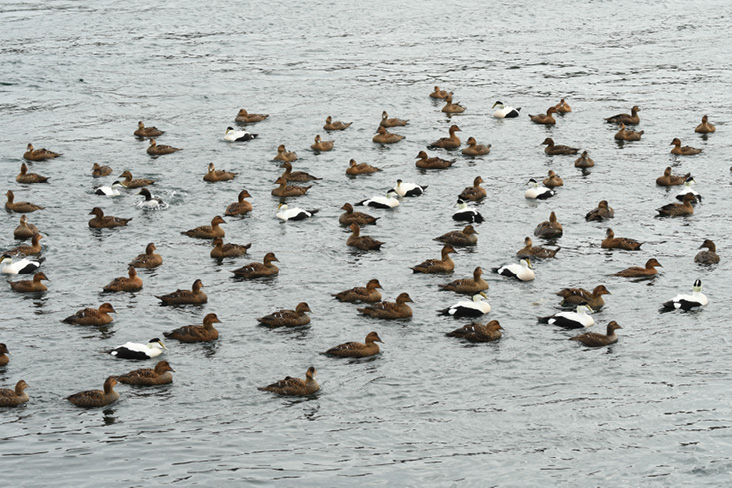
Eider flock.
Continue driving north. At the Harwich/Chatham town line there is a sandy expanse at the mouth of Muddy Creek called Jackknife Cove (BB) that might hold a few birds. The entrance road—on the right—is difficult to see and is down a steep hill. Park and scan the creek where it enters Pleasant Bay. The sandy road maybe flooded at high tide or icy in winter. If that's the case, or you miss the turnoff, you'll soon come to roadside parking on the right next to Pleasant Bay. You can walk along the small beach and view Jackknife Cove from the other side. There are usually plenty of gulls: Herring, Ring-billed, and Black-backed, as well as Black Ducks. In 2016, the federal and Massachusetts governments, along with several local stakeholders, completed a restoration project of Muddy Creek and its estuary, opening natural tidal flow, which has led to the return of fish and many birds, most of which you'll see in other seasons. But it's worth a look in winter, too. This section of Route 28 is dangerous to walk, so cross the road carefully and scan Muddy Creek. Even if all you see are a single Great Blue Heron, Mallards, and Canada Geese, it is a pretty view.
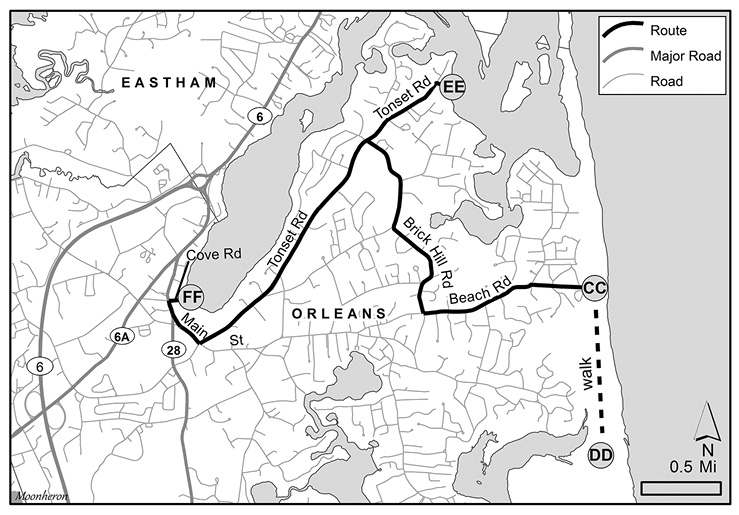
Fig. 4. Map of Nauset
5. Orleans: Nauset Beach to Town Cove
As you enter Orleans (see Figure 4), the barrier beaches block ocean access in most areas. Keep heading north on Route 28 (South) for 5.2 miles. At the traffic light next to the police station and ball field, turn right on Tonset Road. At the next light, turn right on Main Street, which becomes Beach Road and will take you to the Nauset Beach parking lot (CC). Storms and significant erosion have wiped out the dunes and part of the parking lot; in 2019, the Town of Orleans built a new long dune between the beach and the parking lot to protect the area for another 5–10 years. You can park here in winter unless the lot has been flooded in a recent nor'easter. There are good seabirds just offshore—Common Eiders, Red-breasted Mergansers, all three scoters, Common Loons— and a short walk to the north at low to mid tide will likely show Harlequin Ducks at a shallow rocky spot just offshore. Often, there are alcids and Northern Gannets in the distance, and the gannets may come close to shore right after a storm. Look for Sanderlings and small flocks of Dunlin along the water's edge. You can see gray seals here, too, watching you as you watch them.
The more adventurous—and optimistic—can walk a sandy mile to the south on Nauset Beach and access the private land called Pochet Island (DD) (the owners pronounce it Po-chee). There is a bridge over the tidal creek that allows you to visit this property. It is private and should be treated with respect. There are thickets and woodlands and overgrown fields. The open wetland in the center can harbor late night-herons and lots of passerines. This island is a little-visited treasure along the beach. Remember, it is a long walk in soft sand with no shelter from the fierce northeast winds. Plan on at least a two-hour round trip, if not longer.
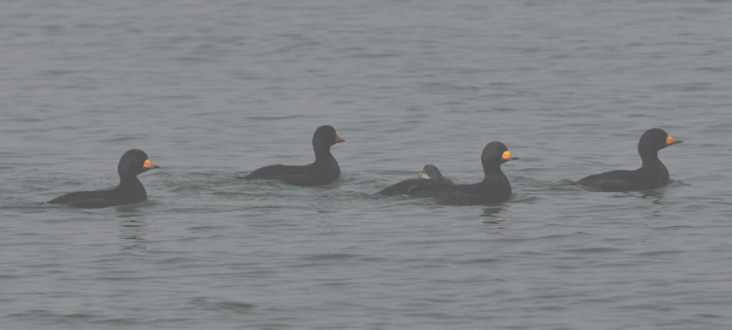
Black Scoter.
When you are finished birding Nauset Beach (whether or not you go all the way out to Pochet), head out to the town landing at the end of Tonset Road (EE), which a small but more sheltered spot to bird Nauset Harbor with Nauset Beach in the distance. Leaving Nauset Beach, drive on Beach Road for 1.1 miles, turn right on Brick Hill Road, and in 1.3 miles, turn right on Tonset Road. In approximately 0.5 mile, Tonset Road curves to the right. Park at the end of the road and bird from the top of the stairs. You will see most of the ducks and gulls you saw at Nauset Beach, minus the Harlequin Ducks, but you may add Common Goldeneyes and a Great Blue Heron in the marsh. If you are lucky, you might be able to scope a distant Snowy Owl out on the marsh grasses or on the dunes at Nauset Beach across the water.
The final stop in Orleans is the Town Cove (FF). Take Tonset Road for about 2.5 miles and turn right on Main Street at the traffic light. Turn right onto Route 28, then take your first right on Cove Road. You can park next to the Orleans Yacht Club's dock and walk out on the dock to scope the water. Along with the usual ducks and geese and Great Cormorants, you never know what surprises might lurk: American Coot, Barrow's Goldeneye, Redhead, Green-winged Teal, Northern Pintail, and Northern Shoveler are occasional but annual.
No trip to Cape Cod would be complete without a stop at Bird Watcher's General Store in Orleans, which is on Route 28 between Cove Road and the Orleans rotary. There are also several restaurants and coffee shops in Orleans that are open for lunch year-round: The Yardarm, The Cottage Street Bakery, Hole in One, The Corner Store, and Homeport. If you plan to stay overnight to bird the outer Cape Cod the next day, you will find a few motels in Orleans that are open year-round. To continue the final loop of the mid-Cape section, get on Route 6 West at the Orleans rotary and take the exits to the beaches along Nantucket Sound that interest you.
6. Nantucket Sound Beaches: Harwich to Hyannis
Nantucket Sound offers several small beaches with parking lots that have potential. From east to west, they are in Harwich, Dennis Port, West Dennis, and Hyannis. At these neighborhood beaches you may stumble on Purple Sandpipers, Brant, and a nice range of sea and bay ducks. Any of the small tidal creeks that drain past these beaches can harbor Greater Yellowlegs and Hooded Mergansers along their marshy edges. Red River Beach (GG) (take Exit 11) and Saquatucket Harbor (HH) (take Exit 11 or Exit 10), the two most easterly of the Harwich beaches, are worth a look, particularly after a storm. In Dennis Port, take Exit 9A for Sea Street Beach (II), which is the most productive, though there are half a dozen small overlooks along this shoreline.
The best of the Nantucket Sound birding spots is West Dennis Beach (JJ) (take Exit 9A). This is a long beach along Nantucket Sound that also has extensive salt marsh habitats to look over, as well as dunes and beach grass. It is a regular wintering spot on Cape Cod for Snowy Owls and lingering herons and egrets. The parking lots provide edges that collect wind-blown seeds; redpolls and Horned Larks, along with the Song Sparrows, can sometimes be seen gleaning from these areas.
Finally, Hyannis beaches of note (all accessed from Exit 7) are Kalmus Beach (KK), Keyes Memorial Beach (LL), and Ocean Avenue Beach (MM). Kalmus Beach, at the mouth of Lewis Bay, is a good stop for bathrooms and a quick look at the water. Bay ducks and gulls are often pretty good along these beaches. These beaches are tidal and are best birded at the lower tides. Most of the sought-after species will be on the cusp of winter and include Bonaparte's and Black-headed gulls, Hooded Mergansers, and passerines that use salt marshes. All of the south-facing beaches along Nantucket Sound will have Long-tailed Ducks and all three scoters. There have been good numbers of Black Scoters in these waters. On a ferry ride to Nantucket or Martha's Vineyard from Hyannis, you will often pass by hundreds of scoters, loons, and Long-tailed ducks.
That wraps up the eastern section of the mid-Cape; no matter how you choose to bird the area from Barnstable to Orleans, keep in mind that every beach, thicket, and feeder just might hold another pleasant surprise.
eBird Hotspots in the Mid-Cape Cod Area
Massachusetts has the distinction of having a lot of birders and, hence, many entries into eBird. The downside is that there are many, many hotspots promulgated for Massachusetts—how do you choose? Below, I've chosen several mid-Cape Barnstable County hotspots, some that I discussed in the article and others that I didn't mention. The hotspots that are reasonable to visit in winter are marked with an *. The others may be worth a stop if you have the time but are better in other seasons.
- Navigation Road (Barnstable) *
- Sea Gull Beach (Yarmouth) *
- Bells Neck Conservation Area (Dennis)
- Corporation Beach (Dennis) *
- West Dennis Beach (Dennis) *
- Crowes Pasture (Dennis)
- Chapin Beach (Dennis) *
- Cold Brook Preserve (Harwich)
- Red River Beach (Harwich) *
- Nickerson State Park (Brewster)
- Wing Island (Brewster)
- Monomoy (5 Chatham spots) *
- Morris Island Causeway (Chatham) *
- Chatham Fish Pier (Chatham) *
- Tern Island Sanctuary (Chatham)
- Frost Fish Creek (Chatham)
- Cow Yard Lane (Chatham)
- Outermost Harbor (Chatham) *
- Forest Beach & Conservation Area (Chatham) *
- Chatham Lighthouse (Chatham) *
Cape Cod has been birded by generations of folks: Archie Hagar, Ludlow Griscom, Norman Hill, Bob Fox, Wallace and Priscilla Bailey, Brad Blodgett, Vernon Laux, Dick Forster, Wayne Petersen, Peter and Jeremiah Trimble, Simon Perkins, Pete Flood, Peter Trull, and Blair Nikula—and dozens of others. There is a wealth of bird information that is online and on old daily field lists. For the sake of understanding bird populations and movements and to allow fact-based planning for habitat protection and management, I urge everyone to get their data into eBird. This resource has become the largest bird database around. Please contribute.
Final Comments
If you are traveling on a Sunday morning tune in to Ray Brown's Talkin' Birds on WATD 95.9 at 9:30. This is a Marshfield-based radio station with reasonable coverage onto the Cape.
If you are traveling on the second Tuesday of the month listen to an hour of Bird News with Mark Faherty on "The Point" with Mindy Todd on Cape Cod's local NPR station (WCAI 94.3 FM).
Mark is also on NPR (WCAI; 94.3 FM) every Wednesday morning at 8:45 with a local Bird Report.
And, of course, plan a stop at Mike O'Connor's Bird Watcher's General Store in Orleans near the Orleans rotary.
David Clapp worked for Mass Audubon and the Smithsonian for 35 years. A Cape Cod property owner since the early 1980s, he has grown to treasure his time on this sandy arm. Aside from those Cape birders mentioned above, he would like to thank others who commented for this article or have birded the Cape with him over the years: Dennis Peacock, David Ludlow, Mike Emmons, Dan Furbish, Chris Dalton, Melissa Lowe, Bob Prescott, Mike O'Connor, and, of course, TLF (The Lovely Frances), his wife and favorite birding companion.